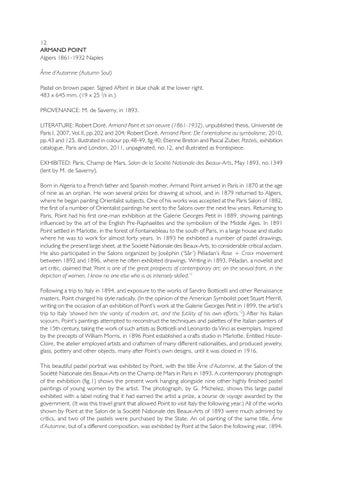12 ARMAND POINT Algiers 1861-1932 Naples Âme d’Automne (Autumn Soul) Pastel on brown paper. Signed APoint in blue chalk at the lower right. 483 x 645 mm. (19 x 25 3/ 8 in.) PROVENANCE: M. de Saverny, in 1893. LITERATURE: Robert Doré, Armand Point et son oeuvre (1861-1932), unpublished thesis, Université de Paris I, 2007, Vol.II, pp.202 and 204; Robert Doré, Armand Point: De l’orientalisme au symbolisme, 2010, pp.43 and 125, illustrated in colour pp.48-49, fig.40; Etienne Breton and Pascal Zuber, Pastels, exhibition catalogue, Paris and London, 2011, unpaginated, no.12, and illustrated as frontispiece. EXHIBITED: Paris, Champ de Mars, Salon de la Société Nationale des Beaux-Arts, May 1893, no.1349 (lent by M. de Saverny). Born in Algeria to a French father and Spanish mother, Armand Point arrived in Paris in 1870 at the age of nine as an orphan. He won several prizes for drawing at school, and in 1879 returned to Algiers, where he began painting Orientalist subjects. One of his works was accepted at the Paris Salon of 1882, the first of a number of Orientalist paintings he sent to the Salons over the next few years. Returning to Paris, Point had his first one-man exhibition at the Galerie Georges Petit in 1889, showing paintings influenced by the art of the English Pre-Raphaelites and the symbolism of the Middle Ages. In 1891 Point settled in Marlotte, in the forest of Fontainebleau to the south of Paris, in a large house and studio where he was to work for almost forty years. In 1893 he exhibited a number of pastel drawings, including the present large sheet, at the Societé Nationale des Beaux-Arts, to considerable critical acclaim. He also participated in the Salons organized by Joséphin (‘Sâr’) Péladan’s Rose + Croix movement between 1892 and 1896, where he often exhibited drawings. Writing in 1893, Péladan, a novelist and art critic, claimed that ‘Point is one of the great prospects of contemporary art; on the sexual front, in the depiction of women, I know no one else who is as intensely skilled.’1 Following a trip to Italy in 1894, and exposure to the works of Sandro Botticelli and other Renaissance masters, Point changed his style radically. (In the opinion of the American Symbolist poet Stuart Merrill, writing on the occasion of an exhibition of Point’s work at the Galerie Georges Petit in 1899, the artist’s trip to Italy ‘showed him the vanity of modern art, and the futility of his own efforts.’2) After his Italian sojourn, Point’s paintings attempted to reconstruct the techniques and palettes of the Italian painters of the 15th century, taking the work of such artists as Botticelli and Leonardo da Vinci as exemplars. Inspired by the precepts of William Morris, in 1896 Point established a crafts studio in Marlotte. Entitled HauteClaire, the atelier employed artists and craftsmen of many different nationalities, and produced jewelry, glass, pottery and other objects, many after Point’s own designs, until it was closed in 1916. This beautiful pastel portrait was exhibited by Point, with the title Âme d’Automne, at the Salon of the Société Nationale des Beaux-Arts on the Champ de Mars in Paris in 1893. A contemporary photograph of the exhibition (fig.1) shows the present work hanging alongside nine other highly finished pastel paintings of young women by the artist. The photograph, by G. Michelez, shows this large pastel exhibited with a label noting that it had earned the artist a prize, a bourse de voyage awarded by the government. (It was this travel grant that allowed Point to visit Italy the following year.) All of the works shown by Point at the Salon de la Société Nationale des Beaux-Arts of 1893 were much admired by critics, and two of the pastels were purchased by the State. An oil painting of the same title, Âme d’Automne, but of a different composition, was exhibited by Point at the Salon the following year, 1894.
Issuu converts static files into: digital portfolios, online yearbooks, online catalogs, digital photo albums and more. Sign up and create your flipbook.
